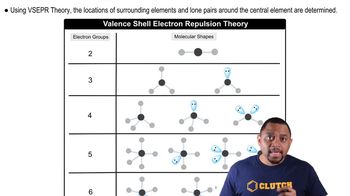Determine the geometry about each interior atom in each molecule and sketch the molecule. (Skeletal structure is indicated in parentheses.) a. CH3OH (H3COH) b. CH3OCH3 (H3COCH3)
Ch.10 - Chemical Bonding II: Molecular Shapes & Valence Bond Theory

All textbooks Tro 4th Edition
Tro 4th Edition Ch.10 - Chemical Bonding II: Molecular Shapes & Valence Bond Theory
Ch.10 - Chemical Bonding II: Molecular Shapes & Valence Bond Theory Problem 46c
Problem 46c
 Tro 4th Edition
Tro 4th Edition Ch.10 - Chemical Bonding II: Molecular Shapes & Valence Bond Theory
Ch.10 - Chemical Bonding II: Molecular Shapes & Valence Bond Theory Problem 46c
Problem 46cChapter 10, Problem 46c
Determine the geometry about each interior atom in each molecule and sketch the molecule. (Skeletal structure is indicated in parentheses.) c. NH2CO2H (H2NCOOH both O atoms attached to C)
 Verified step by step guidance
Verified step by step guidance1
Identify the central atoms in the molecule NH_2CO_2H. The central atoms are nitrogen (N) and carbon (C).
Determine the geometry around the nitrogen atom. Nitrogen in NH_2 typically forms three bonds and has one lone pair, leading to a trigonal pyramidal geometry.
Determine the geometry around the carbon atom. Carbon in CO_2H forms four bonds (two with oxygen, one with nitrogen, and one with hydrogen), leading to a tetrahedral geometry.
Consider the geometry around the oxygen atoms. Each oxygen in CO_2H forms two bonds and has two lone pairs, leading to a bent or angular geometry.
Sketch the molecule by placing the atoms according to their geometries: nitrogen with a trigonal pyramidal shape, carbon with a tetrahedral shape, and oxygen with a bent shape. Connect the atoms as indicated in the skeletal structure.

Verified video answer for a similar problem:
This video solution was recommended by our tutors as helpful for the problem above.
Video duration:
5mWas this helpful?
Key Concepts
Here are the essential concepts you must grasp in order to answer the question correctly.
Molecular Geometry
Molecular geometry refers to the three-dimensional arrangement of atoms within a molecule. It is determined by the number of bonding pairs and lone pairs of electrons around the central atom, which influences the shape of the molecule. Common geometries include linear, trigonal planar, tetrahedral, and bent, each resulting from specific arrangements of electron pairs according to VSEPR (Valence Shell Electron Pair Repulsion) theory.
Recommended video:
Guided course

Molecular Geometry with Two Electron Groups
VSEPR Theory
VSEPR theory is a model used to predict the geometry of individual molecules based on the repulsion between electron pairs in the valence shell of the central atom. According to this theory, electron pairs will arrange themselves as far apart as possible to minimize repulsion, leading to specific molecular shapes. This theory is essential for determining the spatial arrangement of atoms in a molecule like NH2CO2H.
Recommended video:
Guided course

Molecular Shapes and VSEPR
Skeletal Structure
A skeletal structure is a simplified representation of a molecule that shows the connectivity between atoms without depicting all the hydrogen atoms explicitly. In skeletal formulas, carbon atoms are typically represented by vertices or ends of lines, while other atoms like oxygen and nitrogen are shown explicitly. Understanding skeletal structures is crucial for visualizing molecular geometry and determining the arrangement of atoms in compounds such as NH2CO2H.
Recommended video:
Guided course

Skeletal Formula
Related Practice
Textbook Question
427
views
Textbook Question
Determine the geometry about each interior atom in each molecule and sketch the molecule. (Skeletal structure is indicated in parentheses.) c. H2O2 (HOOH)
968
views
Textbook Question
Determine the geometry about each interior atom in each molecule and sketch the molecule. (Skeletal structure is indicated in parentheses.)
a. CH3NH2 (H3CNH2)
b. CH3CO2CH3 (H3CCOOCH3 One O atom attached to 2nd C atom; the other O atom is bonded to the 2nd and 3rd C atom)
1814
views
Textbook Question
Explain why CO2 and CCl4 are both nonpolar even though they contain polar bonds.
1610
views
Textbook Question
CH3F is a polar molecule, even though the tetrahedral geometry often leads to nonpolar molecules. Explain.
4481
views
Textbook Question
Determine whether each molecule in Exercise 35 is polar or nonpolar. a. PF3 b. SBr2 c. CHCl3 d. CS2
736
views